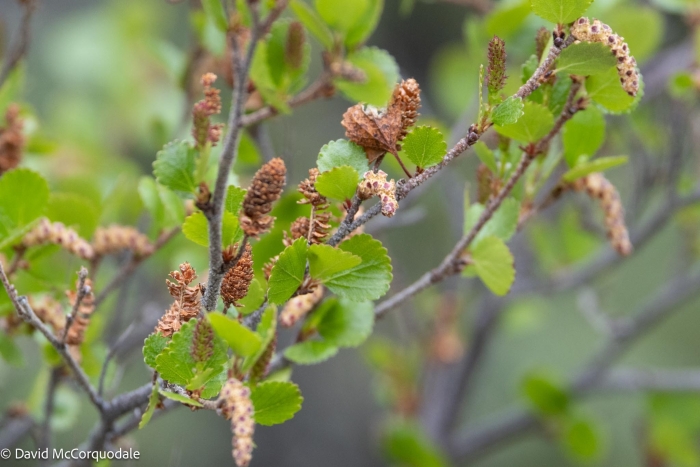Dwarf Birch
(Betula nana)
Dwarf Birch (Betula nana)
/
/

David McCorquodale
CC BY 4.0
Image By:
David McCorquodale
Recorded By:
Copyright:
CC BY 4.0
Copyright Notice:
Photo by: David McCorquodale | License Type: CC BY 4.0 | License URL: http://creativecommons.org/licenses/by/4.0/ | Rights Holder: David McCorquodale | Publisher: iNaturalist | Date Created: 2023-06-07T13:58:58-07:00 |

























Estimated Native Range
Summary
Betula nana, commonly known as Dwarf Birch, is a monoecious deciduous shrub native to tundra and subarctic regions, including Greenland, Iceland, northern Europe, northern Asia, and northern North America. It is adapted to cold climates and typically grows up to 4 feet high. Dwarf Birch has a compact, rounded form with small, rounded, toothed leaves that turn yellow in the fall. The bark is distinctive with its non-peeling, reddish-copper color. It produces inconspicuous flowers in the form of catkins, which are followed by small winged seeds.
Dwarf Birch is valued for its hardiness in extreme northern climates and its ability to thrive in poor soil conditions. It is often used in restoration projects to stabilize soil and support local ecosystems. In cultivation, it requires wet but well-drained, acidic soils and can tolerate nutrient-poor conditions. It is found at altitudes up to 7218 feet and is a key species in tundra biodiversity, providing habitat and food for Arctic wildlife. Dwarf Birch is not commonly used in traditional gardens but can be a unique addition to rock gardens or used in mass plantings for erosion control. It prefers full sun to partial shade and is relatively low maintenance, though it may not be suitable for warmer climates.CC BY-SA 4.0
Dwarf Birch is valued for its hardiness in extreme northern climates and its ability to thrive in poor soil conditions. It is often used in restoration projects to stabilize soil and support local ecosystems. In cultivation, it requires wet but well-drained, acidic soils and can tolerate nutrient-poor conditions. It is found at altitudes up to 7218 feet and is a key species in tundra biodiversity, providing habitat and food for Arctic wildlife. Dwarf Birch is not commonly used in traditional gardens but can be a unique addition to rock gardens or used in mass plantings for erosion control. It prefers full sun to partial shade and is relatively low maintenance, though it may not be suitable for warmer climates.CC BY-SA 4.0
Plant Description
- Plant Type: Shrub
- Height: 1.9-3 feet
- Width: 3-4 feet
- Growth Rate: Moderate
- Flower Color: N/A
- Flowering Season: Spring
- Leaf Retention: Deciduous
Growth Requirements
- Sun: Full Sun, Part Shade
- Water: Medium
- Drainage: Fast, Medium, Slow
Common Uses
Bank Stabilization, Low Maintenance, Water Garden
Natural Habitat
Tundra and subarctic regions
Other Names
Common Names: Dwarf Birch, Arctic Birch, Alpine Birch, Bog Birch
Scientific Names: , Betula nana, Alnus nana, Betula alba subsp. nana, Betula crenata, Betula glandulosa f. intermedia, Betula littelliana, Betula nana f. magnifolia, Betula nana f. reducta, Betula nana subsp. relicta
GBIF Accepted Name: